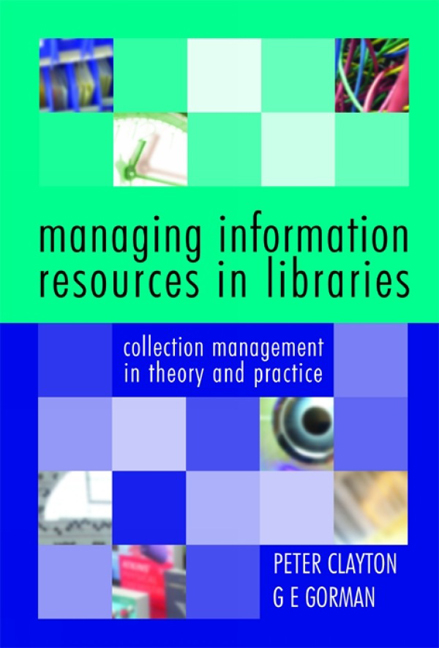Book contents
- Frontmatter
- Contents
- About the authors
- Preface
- 1 Managing information resources in context
- 2 Collection management and collection development policies
- 3 Conspectus
- 4 Resource sharing and co-operative collection development
- 5 Selection: policies and procedures
- 6 Selection resources
- 7 Acquisitions processes and procedures
- 8 Budget management
- 9 Collection evaluation and review
- 10 Preservation and weeding
- The literature of collection management Adela Clayton
- Index
9 - Collection evaluation and review
Published online by Cambridge University Press: 08 June 2018
- Frontmatter
- Contents
- About the authors
- Preface
- 1 Managing information resources in context
- 2 Collection management and collection development policies
- 3 Conspectus
- 4 Resource sharing and co-operative collection development
- 5 Selection: policies and procedures
- 6 Selection resources
- 7 Acquisitions processes and procedures
- 8 Budget management
- 9 Collection evaluation and review
- 10 Preservation and weeding
- The literature of collection management Adela Clayton
- Index
Summary
Focus questions
• What are the reasons for collection evaluation?
• What procedures are involved in collection evaluation?
• What are the principal user-centred methods of collection evaluation?
• What are the principal collection-centred methods of collection evaluation?
Accountability, especially among public sector organizations, has become a driving force behind the growing emphasis on and interest in performance indicators. At one time collection managers were content to regard the size of a collection as the measure of its worth, but we have moved beyond this simplistic approach. As Magrill and East warned more than two decades ago,
… there are those who distrust the seemingly precise results obtained from manipulation of basic figures subjectively assigned. In some of the operations research applications, models are based on assumptions which cannot be verified by librarians in their day-to-day experiences with library users.
Today we are more inclined to use performance indicators to ‘prove’ that our funds are being expended in return for improved services that benefit the widest possible range of users. In terms of collection management, collection evaluation and review is essentially a means of gathering and assessing performance indicators about the use and strength of collections of information resources. Therefore, it is an essential component in the accountability process. The growing emphasis on accountability has been accompanied by significant advances in the ability of automated library systems to provide tailored management information reports that can be used for data collection and analysis, and this has facilitated the conduct and use of collection evaluation studies. Combine the current management ethos with technological capabilities, and we have the potential for revived interest in collection evaluation as part of collection management after a period of relative neglect.
In most countries developments along these lines have been relatively haphazard, or have focused on one specific aspect – for example, in the USA (and much less in Britain) these has been emphasis on Conspectus as the most appropriate approach to evaluation (see Chapter 3). In the UK a series of discrete reports, when combined, provide an excellent set of performance evaluation guidelines – most notably the compilation by Bohme and Spiller; these are discussed at some length by David Spiller.
- Type
- Chapter
- Information
- Managing Information Resources in LibrariesCollection Management in Theory and Practice, pp. 160 - 186Publisher: FacetPrint publication year: 2006



